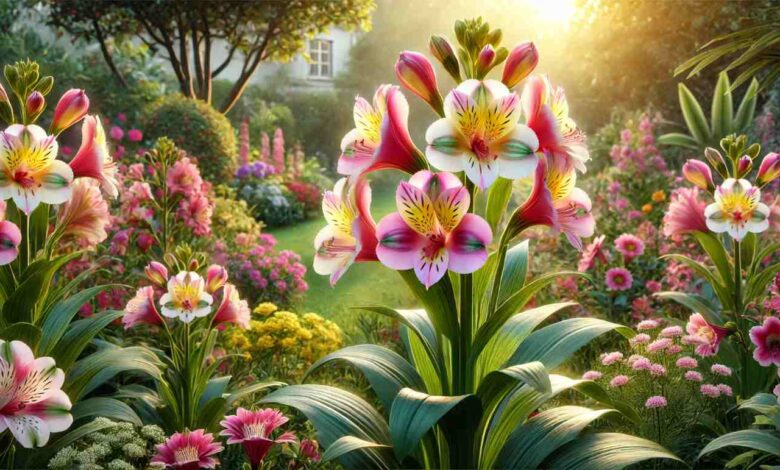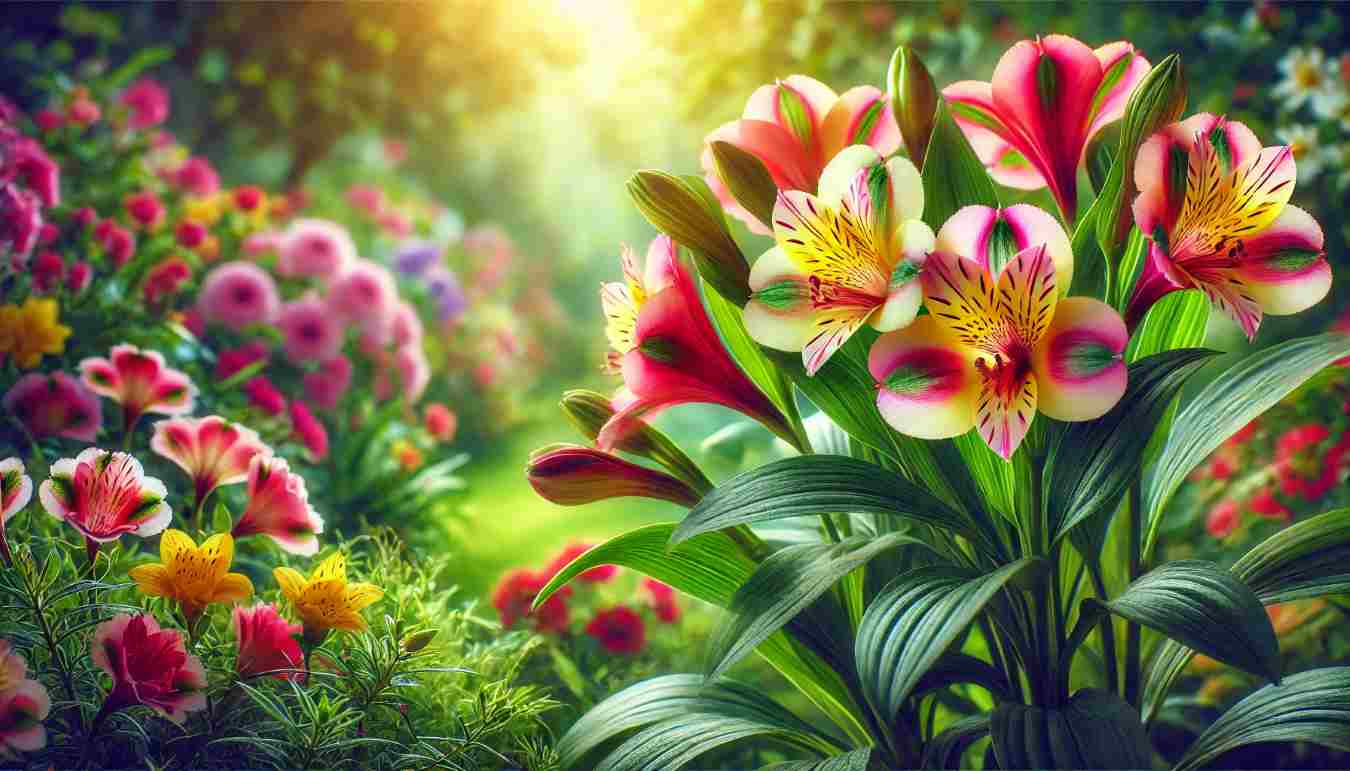Alstromeria: Meaning, Care, Growth, and More

Alstromeria, also known as the Peruvian lily or Lily of the Incas, is a stunning flower that has captured the hearts of gardeners and flower enthusiasts alike. Its bright, multi-colored petals and resilient nature make it a fantastic addition to gardens, bouquets, and even pots. But there’s much more to this flower than its beauty. Let’s explore the meaning, care, growth tips, and everything you need to know about this lovely plant.
The Meaning of Alstromeria
Alstromeria holds profound significance and is a popular choice for gifting due to its symbolic meaning. It represents friendship, dedication, and mutual support. Each of its six petals symbolizes essential qualities for a strong friendship: understanding, patience, humor, empathy, commitment, and respect. Its colors further enhance its meaning, with pink representing love and care, yellow symbolizing happiness, and white denoting purity and new beginnings. Whether you’re presenting this flower as a gift or nurturing it in your garden, its message of deep connection and love remains ever-present.
Growing Alstromeria: Planting and Care Tips
Sunlight and Soil Requirements
Full sun is best, but part shade gives alstromeria the type of break from the heat they need. For optimal growth, put your flowers where they will receive sunlight in the daytime and some shade within the afternoon, particularly in warmer climates. Soil should be well-drained, fertile, and organically rich. Make sure the planting area or potting mix is well watered, but not waterlogged. Overwatering may cause root rot—make sure your potted plant has proper drainage as well.
Watering and Fertilization
Regular watering is very important when planting alstromeria, especially during the first growth period. Water the soil so that it remains consistently moist, but do not waterlog it. The plant can handle a bit of drought once established, but it should get watered about once or twice per week. Mulching around the base regulates moisture and temperature. Apply a balanced, slow-release fertilizer in the growing season or use high potash feed during flowering times to give them as bright of a bloom they can.
Pruning and Deadheading
Regular deadheading is most important when it comes to ensuring that your alstromeria continues to bloom throughout the season. Instead of snipping the stems, pull from the base (stem included) so that it grows back. This method also allows the plant to save energy and encourages a new bloom of fresh flowers. Spring is the time to cut out dead or broken stems so new growth can take over.

Propagation and Growth
Alstromeria is propagated from seeds or by division of tuberous roots. While seed propagation is less viable because of low germination rates, seeds can be used by the adventurous gardener who takes on a challenge. The most common and tried-and-true method is dividing the tuberous clumps in early spring. Division of each should include a few healthy tubers and can be replanted immediately.
This will make the flowering more quickly, and you also get to enjoy your Alstromeria across a while of your garden. Most Alstromeria grow 12 to 36 inches tall, so they fit equally well into a garden border or in pots on the patio. Dwarf types can be grown in containers and will provide plenty of flowers from summer through fall.
Common Problems and Pests
Alstromeria are easily grown from seed or by dividing tuberous roots. Seed propagation, while less common because of poor germination rates, is an option for adventurous gardeners. A far simpler and more consistent method is dividing your main clumps of tubers in early spring. They should each have a couple of healthy tubers and can be replanted right away.
This ensures faster blooming and allows you to spread the beauty of Alstromerias throughout your garden. Alstromeria, commonly known as Peruvian Lily, making them ideal for garden borders or pots. Even compact types can be grown in pots and still provide a profusion of blooms from summer through fall.
Overwintering Alstromeria
Alstromeria may need some additional protection where winters are severe. In hardiness zones 8-10, the plant can be planted outside to remain outdoors year-round. In colder locations, though, you are going to have to dig up the tubers before it entirely goes through a deep freeze. Keep them in a cool, dark place until spring, when they’ll be ready to plant again. Or, if you have alstromeriabulbs grown in pots, then you can take the pots inside during winter.
The Beauty of Alstromeria in Arrangements
Alstromeria is not just a garden plant; it is also a preferred option for floral arrangements. Its enduring blooms make it a popular choice for bouquets, and with proper care, these flowers can remain fresh for up to two weeks in a vase. To achieve optimal results, cut the stems at an angle, place them in fresh water with flower food, and replace the water every few days. Furthermore, keeping the arrangement out of direct sunlight will help preserve the vibrancy of the blooms for a longer duration.
FAQs
1. What is Alstroemeria known for?
Alstroemeria, commonly called the “friendship flower,” is famous for its vibrant, long-lasting blooms. It symbolizes devotion, mutual support, and continual growth. Popular as a cut flower, it is admired for its wide color variety and ability to withstand cold.
2. What is another name for Alstroemeria?
Alstroemeria is also known as the Peruvian lily or the Lily of the Incas. Although it bears a strong resemblance to lilies, it is not a true lily.
3. How poisonous is Alstroemeria?
Alstroemeria bulbs produce a compound called tulipalin, which is toxic to both people and pets. Ingestion may irritate the mouth and digestive tract. Its sap can also cause skin irritation, so wearing gloves when handling the plant is advisable.
4. What is the most poisonous flower in the world?
The very poisonous flower Nerium oleander contains oleandrin, a toxic compound present in high concentrations, making it lethal if ingested. It can cause extreme illness or death.
5. Are lilies safe for humans?
While most lilies (Lilium species) are not serious to humans, their sap can irritate the skin, and some are dangerous in large amounts. However, lilies are highly toxic to cats, and even small exposure can cause acute kidney failure in them.
6. Is Alstroemeria safe for pets?
Alstroemeria is mildly toxic to pets. While generally non-lethal, ingestion can result in oral irritation, vomiting, and gastrointestinal distress in both cats and dogs.
The Bottom Line
But they’re so much more than a beautiful flower – there’s meaning behind the alstromeria: friendship, cuffed sleeves, and endurance. With a little care, it will flourish right in your backyard or home and bring with it the colorful blooms of happiness from spring well into fall. Plant it in the ground, wow them in a vase, and use this flower for even more impactful planting displays with pots. Alstromeriais a beautiful plant that, if you buy the right one for your garden, it will be an exciting plant to own, growing in most gardens and rewarding any gardener, whether experienced or just starting.




